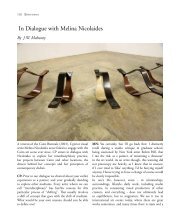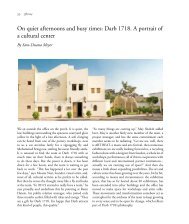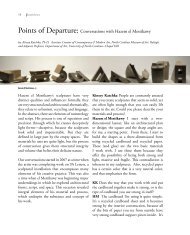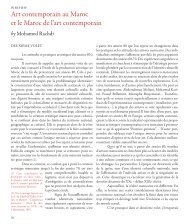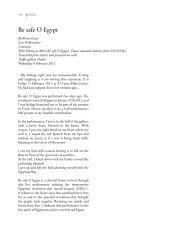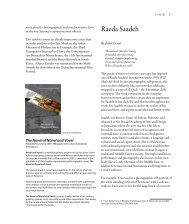Nikoo Tarkhani - Contemporary Practices
Nikoo Tarkhani - Contemporary Practices
Nikoo Tarkhani - Contemporary Practices
You also want an ePaper? Increase the reach of your titles
YUMPU automatically turns print PDFs into web optimized ePapers that Google loves.
Profiles<br />
167<br />
new ones in order to live a better feminine life or to set<br />
her ancient fears, wishes and resistances free. Student of<br />
a realist painting atelier, <strong>Tarkhani</strong> began her career with a<br />
series of nude auto portraits. Along with ample works of<br />
the artist, early nude self-portraits are all prima oil color<br />
plates illustrating the bust of the artist while having her<br />
feminine sexual features masked, removed or vanished<br />
into background. Effigy of the nude artist, intentionally<br />
missing almost all of her entire sexual identity, is the<br />
juxtaposition of myriad metaphors. As she poses for<br />
herself she becomes an original inauthentic1 figurine<br />
who caresses herself, taunts the author and vanishes<br />
through the plane and motionless world from whence<br />
she once sprung. This pristine silent dynamism of<br />
shifting gestures freezes in time.<br />
In the series “This is not a woman” she portrays central<br />
psychoanalytic questions of the woman. By questioning<br />
the thing that the woman conceals within the veil,<br />
<strong>Nikoo</strong> opposes what she reads from attraction, sexuality<br />
and desire and reduces her body to a sometimes sexless<br />
imaginary identity. However, the identity takes shape<br />
even during the absence of her sexual features as the<br />
woman. In the poses she desperately longs for a never<br />
arriving moment of revelation; the ‘jouissance’ that is<br />
to retrograde as it moves towards the very end of the<br />
author’s neurotic speech. In this short burst of clarity<br />
both the viewer and the persona are suffering at the<br />
same time. As a token bestowed upon revenge they<br />
deliberately introduce themselves as an antithesis of the<br />
other’s comfort. <strong>Nikoo</strong>, as she has portrayed herself,<br />
is a nearly faint seductress hopelessly playing her last<br />
card. Numbly, her flesh and skin make enquiry as she<br />
caresses the absence of her objective femininity. This<br />
is the paradox of her veiling hands whose fondles<br />
contemporaneously mask the reference to its eroticism.<br />
This neurosis is accompanied by a meticulously<br />
rendered context of repeating tiles ornamented with<br />
floral symmetries. Although the beauty of each portrait<br />
is devoured by pain and drenched in imperfection, and<br />
every inch of this harmony is anything but expected,<br />
she managed to appear within a traditional stillness of<br />
conservative boredom that reproduces itself in absolute<br />
narcissism: the traditional normative that has nurtured<br />
her existence and tended to keep her safe from harm;<br />
the tradition of the father. .<br />
<strong>Nikoo</strong> understands and accepts her definite feminine<br />
subjectivity as she begins to embody the disembodied<br />
neighbor woman. While she illustrates her naked<br />
body as the fleshly indisputable truth, she defines her<br />
embodied self as the support for her specificities that are<br />
declined by the overgeneralized desire of the father. Yet,<br />
it also depicts the long-running wish/fear of the father<br />
toward the flesh. Not only do the norms and venues<br />
aggressively responded to her nouvelle body by blaming<br />
their obscenity, but also did the images in the frames.<br />
As the bodies are caressed by their owners they reveal a<br />
discomfort in the subject considering the presence of<br />
the father. Father sets the blame of guilt while <strong>Nikoo</strong><br />
portrays the same sensation. Using this structure and<br />
having her body as a support to validate her standpoint,<br />
she develops her unique association with the father; the<br />
father as the reaction of the father. Partially related to<br />
the region’s feminist community, in her work she has<br />
never offered an alternative reading to the patriarchy<br />
but rather she has represented the feminine as a radically<br />
different text than those of the father. Similar to the<br />
other artists in the region, she depicts the feminine as a<br />
repressed subject, but she also claims that the repressors<br />
and the structure in which the repressions are applied<br />
are crucial factors when defining a Middle Eastern<br />
female subject. This way the seemingly interminable<br />
issue of feminine subjectivity in the Middle East steps<br />
in a new direction. Using this approach she not only<br />
concludes the feminist story in a different way but she<br />
also provides a fine illustration of the establishment<br />
moment of a patriarchy and the initiation of a<br />
feminine subject to the cult of the father. In her entire<br />
catalogue, <strong>Tarkhani</strong> takes a fluctuating approach to<br />
portrait painting. As she reproduces herself in her<br />
earlier works, aware of the other’s gazing eye, she tends<br />
to pose or impersonate a certain gesture. The gestures<br />
are conscious of the gazing eye, hence the persona is<br />
concealed by herself. Though it is neither of pure shame<br />
nor of a willing postponement in the revelation of the<br />
divine, obscurity remains the centerpiece of the works.<br />
The covered elements are illustrating an absence of what<br />
is to be presented as the subject matter of the plates.<br />
The images are agonized in the intentional declination<br />
of the subject’s gender. In her early nude series the<br />
tormenting presence of a supposed audience enunciates



